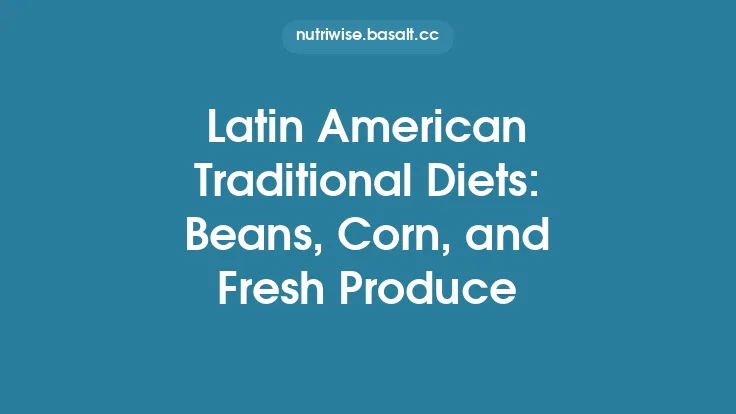Latin American family‑style dining is built around the idea that a meal is a communal event, a celebration of togetherness, and a practical way to ensure that everyone at the table receives a balanced mix of nutrients. Rather than individual plates, dishes are placed in the center of the table and passed around, allowing each person to assemble a personal portion that reflects personal taste, appetite, and nutritional needs. This approach, rooted in centuries‑old agricultural practices and social customs, creates a natural system of nutrient distribution that is both flexible and nutritionally sound.
Historical Roots of Shared Dining
The tradition of communal eating in Latin America can be traced back to pre‑colonial societies such as the Maya, Aztec, and Inca, where large cooking vessels (e.g., *pachamanca pits, cazuelas, and potos*) were used to prepare meals for entire villages. Food was often cooked over open fire or in earth ovens, producing generous quantities that were meant to be shared. The Spanish colonization introduced new ingredients—wheat, pork, dairy, and a variety of spices—yet the communal serving style persisted, merging indigenous and European influences into a distinctive family‑style format.
Core Components of a Latin American Family Meal
A typical family‑style spread includes several foundational categories:
| Category | Typical Items | Nutritional Role |
|---|---|---|
| Starches | Corn tortillas, rice, yucca, plantains, potatoes | Primary source of complex carbohydrates, providing energy and dietary fiber. |
| Legumes | Black beans, pinto beans, lentils, chickpeas | High‑quality plant protein, iron, folate, and soluble fiber that moderates blood glucose. |
| Proteins | Grilled or stewed meats (beef, pork, chicken), fish, chorizo, tofu (in modern adaptations) | Complete proteins, essential amino acids, B‑vitamins, and minerals such as zinc and selenium. |
| Vegetables | Sautéed peppers, onions, tomatoes, squash, leafy greens (e.g., kale, spinach) | Vitamins A, C, K, potassium, and phytonutrients with antioxidant properties. |
| Fruits | Fresh tropical fruit (mango, papaya, pineapple), citrus, avocado | Simple sugars for quick energy, fiber, vitamin C, and healthy monounsaturated fats (avocado). |
| Fats & Condiments | Olive oil, lard, coconut oil, cheese, crema, salsa, chimichurri | Energy-dense lipids, fat‑soluble vitamins (A, D, E, K), and flavor enhancers that stimulate appetite. |
These categories are deliberately interwoven on the table, encouraging diners to combine items in ways that naturally balance macronutrients (carbohydrates, proteins, fats) and micronutrients (vitamins, minerals).
Plate Composition and Nutrient Balance
Because each diner assembles their own plate, the distribution of nutrients is self‑regulated. Research on communal eating patterns shows that people tend to follow a “plate model” instinctively: roughly half the plate is filled with vegetables, a quarter with protein, and a quarter with starches. In Latin American settings, this model is reinforced by cultural cues:
- Visual Cueing – Brightly colored vegetables (red peppers, green cilantro) draw the eye, prompting larger portions of micronutrient‑rich foods.
- Flavor Pairing – The acidity of salsa or the heat of *ají* stimulates salivation, which can increase satiety signals and reduce over‑consumption of starches.
- Portion Flexibility – Since dishes are shared, diners can adjust portion sizes in real time, adding more protein or vegetables as hunger cues evolve.
From a technical standpoint, a typical balanced plate might contain:
- Carbohydrates: 45–55 % of total calories, primarily from complex sources (corn, rice, beans) with a low to moderate glycemic index.
- Proteins: 15–20 % of calories, supplied by a mix of animal and plant proteins, ensuring a complete amino acid profile.
- Fats: 25–35 % of calories, largely from unsaturated sources (avocado, olive oil) with occasional saturated fats from pork or cheese for flavor depth.
Micronutrient distribution is similarly diversified: iron from beans and red meat, calcium from cheese and leafy greens, vitamin C from citrus and tomatoes, and potassium from plantains and squash.
Regional Variations and Signature Dishes
While the overarching structure remains consistent, regional cuisines introduce distinct dishes that influence nutrient composition:
- Mexico: *Mole sauces combine chilies, nuts, seeds, and chocolate, adding healthy fats and antioxidants. Tamales* provide a corn‑based starch wrapped in banana leaves, often paired with beans for protein.
- Andean Countries (Peru, Bolivia, Ecuador): Quinoa and amaranth are used as staple grains, boosting protein and essential amino acids. *Ceviche* offers lean fish and vitamin‑C‑rich citrus, enhancing iron absorption.
- Caribbean Nations (Cuba, Dominican Republic, Puerto Rico): Plantains (fried or boiled) contribute resistant starch, while *ropa vieja* (shredded beef) supplies heme iron. Coconut milk in stews adds medium‑chain triglycerides, a quick energy source.
- Southern Cone (Argentina, Uruguay, Chile): Grilled *asado (beef) is central, delivering high‑quality protein and iron. Empanadas* often contain a blend of meat, cheese, and vegetables, creating a micro‑balanced meal within a single pastry.
These regional specialties illustrate how local agriculture and climate shape the macro‑ and micronutrient profile of the shared meal.
The Role of Staples: Corn, Beans, and Rice
Three staples dominate the Latin American table: corn, beans, and rice. Their combined nutritional synergy is noteworthy:
- Corn supplies complex carbohydrates, fiber, and B‑vitamins. When processed into *masa* for tortillas, it retains most of its nutrients.
- Beans are a powerhouse of plant protein, fiber, and minerals. The amino acid profile of beans complements the limiting lysine in corn, creating a complete protein when eaten together.
- Rice (especially brown or red varieties) adds additional carbohydrates and a modest amount of protein, while also contributing magnesium and selenium.
The classic “three‑bean” or “corn‑bean” combination is a time‑tested method of achieving a balanced amino acid profile without animal products, a principle known as *protein complementarity*.
Protein Sources and Their Distribution
Latin American family meals typically feature multiple protein sources on the same table, allowing diners to diversify their intake:
- Animal Proteins: Beef (asado, carne guisada), pork (chicharrón, lechón), chicken (pollo a la brasa), and fish (ceviche, grilled tilapia). These provide heme iron, vitamin B12, and essential fatty acids.
- Plant Proteins: Beans, lentils, and, increasingly, soy‑based products (tofu, tempeh) for vegetarians. These contribute non‑heme iron, folate, and soluble fiber.
- Eggs: Often incorporated into *huevos rancheros or tortilla de papas*, offering a high‑quality protein with choline, important for brain health.
By offering both animal and plant proteins, the meal naturally balances saturated fat intake with unsaturated fats and fiber, supporting cardiovascular health.
Vegetables, Fruits, and Fiber
Vegetables and fruits are not merely side dishes; they are integral to the nutrient matrix:
- Leafy Greens: *Espinaca (spinach) and acelga* (Swiss chard) are rich in iron, calcium, and vitamin K.
- Root Vegetables: *Yuca* (cassava) and *ñame* (yam) provide resistant starch, which feeds gut microbiota and improves glycemic control.
- Tropical Fruits: Papaya, mango, and guava deliver vitamin C, which enhances iron absorption from beans and meat.
- Avocado: A unique fruit high in monounsaturated fat, potassium, and lutein, supporting heart health and eye function.
The high fiber content from beans, whole grains, and vegetables slows glucose absorption, moderates post‑prandial insulin spikes, and promotes satiety.
Fats and Flavor Foundations
Fats in Latin American cuisine serve both culinary and nutritional purposes:
- Olive Oil: Common in coastal regions, it supplies omega‑9 fatty acids and polyphenols.
- Lard and Rendered Pork Fat: Used in traditional *refritos and tamales*, providing flavor and a modest amount of saturated fat that, when balanced with unsaturated fats, does not adversely affect lipid profiles.
- Coconut Milk: Prominent in Caribbean stews, delivering medium‑chain triglycerides (MCTs) that are rapidly oxidized for energy.
- Cheese and Cream: Add calcium, vitamin D (if fortified), and a creamy mouthfeel that encourages slower eating, enhancing satiety signals.
The strategic use of these fats ensures that the meal is energy‑dense enough for active lifestyles while still delivering essential fatty acids.
Cultural Practices that Shape Portioning
Several cultural habits influence how nutrients are distributed on the plate:
- “Pasar la mesa” (passing the table): Dishes are continuously replenished, encouraging diners to take small, repeated servings rather than a single large portion.
- “Comer con la mano” (eating with the hand): In some regions, especially for tacos or arepas, tactile interaction promotes mindfulness and slower consumption.
- “Merienda” (mid‑day snack): A light fruit or a small portion of *empanada* between lunch and dinner helps maintain steady blood glucose levels.
- Celebratory “Fiesta” meals: Larger quantities of protein and fats are served, but the shared nature still allows individuals to self‑regulate intake.
These practices embed nutritional regulation within the social fabric of the meal.
Health Implications and Modern Adaptations
The family‑style model aligns well with contemporary dietary guidelines:
- Portion Control: Self‑serving encourages intuitive eating, reducing the risk of overeating.
- Nutrient Diversity: The presence of multiple food groups on a single table ensures a broad spectrum of vitamins and minerals.
- Social Support: Eating together has been linked to lower stress levels, improved digestion, and better adherence to healthy eating patterns.
Modern adaptations—such as incorporating whole‑grain *tortillas*, using lean cuts of meat, adding quinoa or millet, and substituting plant‑based proteins—enhance the nutritional profile while preserving cultural authenticity.
Practical Tips for Replicating the Experience
- Start with a Base: Lay out a large platter of corn tortillas or rice as the carbohydrate foundation.
- Add Legumes Early: Serve a bowl of seasoned black beans or lentils to ensure protein and fiber are present from the start.
- Layer Proteins: Offer a mix of grilled chicken, sautéed beef strips, and a plant‑based option (e.g., seasoned tofu) to cater to varied preferences.
- Prioritize Colorful Veggies: Arrange sautéed peppers, tomatoes, and leafy greens in a vibrant display to encourage generous vegetable portions.
- Include Healthy Fats: Provide avocado slices, a drizzle of olive oil, and a modest amount of cheese or crema for flavor balance.
- Finish with Fresh Fruit: End the meal with a fruit platter to satisfy sweet cravings while delivering vitamins and fiber.
- Encourage Sharing: Remind diners to pass dishes and refill their plates as needed, fostering the communal rhythm that naturally balances nutrient intake.
By following these steps, anyone can recreate the essence of Latin American family‑style dining—a convivial, nutritionally balanced experience that honors tradition while supporting modern health goals.





